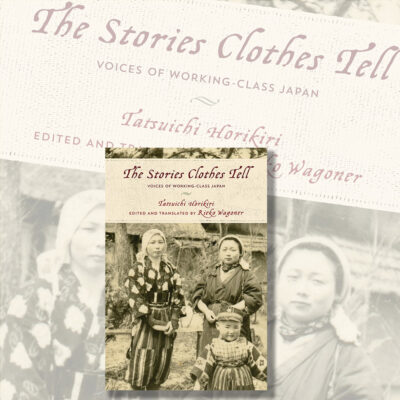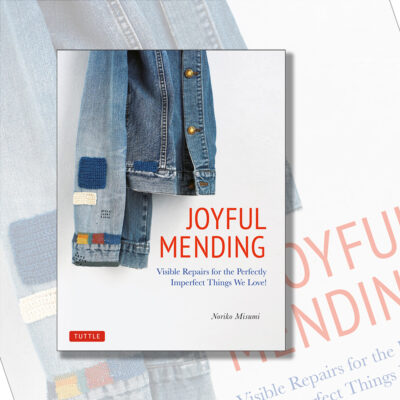
Library Reviews
The Stories Clothes Tell
This is an immensely moving testament to humanity and the struggles faced by ordinary people in the Japan of over a century past. Members of this collective demographic would normally be unremembered as individuals, however they are rediscovered here as a diverse collection of people with snapshots of their lives reconstructed via interviews, anecdotes and a near forensic examination of the clothing they wore.

This book is about the common people (shomin-shi) who constituted the bottom but most populous rung of society. Brutal scarcity meant that clothing was a life enabling possession for keeping warm. In the estimations of the time, were garments to be assessed by characteristics of functionality, durability or beauty; then the quality that was of most importance was durability. An endlessly patched blanket, a threadbare tunic, a mosquito net, an adult diaper – these tangible mementos also echo forgotten ways of life. Older children fostering their younger siblings while parents toiled, gender agnostic mining work, infant mortality and the harsher realities that our ancestors survived.
Tatsuichi Horikiri was born in 1925. A graduate engineer, he served in the war and later ran a construction company. Despite not having any formal academic training, he is now held in esteem for his published knowledge of historic, everyday clothing and recognised as an authority in his field. For over half a century he has zealously chased down old garments and textiles and investigated any stories about their former owners. The Horikiri collection is now more than thirty-five hundred articles in size. A lasting record thanks to one man’s personal efforts and his belief in the value of preserving a comparatively unglamourous class of artifacts and knowledge of their wearers.
from Renting to Rice Cooking
Temporarily set aside the rice part of the title, from Renting to Rice Cooking is a tome of wisdom for travellers levelling up from tourist status. No hostels or couch surfing, this is everything that first time residents didn’t know they needed to know about properly renting a home in Japan.

Be prepared to front a half year’s of rent to cover an overload of fees. Most are not refundable and cash payment is still the norm. An unfurnished abode probably will not even have lights in the fixtures except maybe for the bathroom. Which will not work anyway unless electricity has been arranged. About half a book later and the coverage is able to move on to matters as registering your new address, obtaining a residency card, fixtures, fittings and utilities, importing your existing furniture, pets, sorting the rubbish and more.
It has a print on demand kind of feel which, alongside other editorial imperfections, gives the book an earnest, down to earth touch. The writing style is conversational and has a North American perspective. Izabelle Grenon also frequently interjects her own quips (in bracketed text) into her narrative and readers end up learning a bit about her directly and indirectly. Hanging clothes outside to dry is anointed “a sophisticated integration of wind and solar power”. Japanese garbage truck arrival music instead reminds her of the icecream van.
Additionally, advice is consistently infant and child conscious with plenty of consideration for families and furbabies. Like everything else in this book, these hint at staggeringly frustrating firsthand pain and wasted time that the author is attempting to save others from suffering.
Joyful Mending
Appealing to both the indoor craftsperson or possibly anyone stuck inside and bored. This book teaches a range of techniques to customise clothing into unique, personal fashion statements. Fittingly suitable for sustainability conscious and frugal times.

Have you ever heard of kintsugi, the Japanese art of repairing broken pottery? Joyful Mending shares the same philosophy as kintsugi but with a more contemporary take to suit the modern audience. This crafts project on paper lets you see through the eyes of homemaker Noriko Misumi as she breathes new life to damaged items of clothing.
Noriko Misumi has always been engrossed in art and design, boasting creative content such as @todays_socks on Instagram. As an author, she teaches us her unique style of mending and reusing items based on the concepts of mindfulness and Wabi Sabi. She gently leads us away from consumerist culture and fast fashion by inspiring a rewarding and sustainable movement to mend clothes rather than throw them away. Approaching the repair process as a creative expression, Misumi accents clothing through using simple sewing, embroidery, felting and crocheting techniques.
Through her minimal Japanese craft book, Misumi guides readers through visible and invisible mending techniques that can help restore and preserve treasured pieces of clothing in a fun and fulfilling way.
Table of contents:
Part 1. My mending consultation booth
Part 2. The art of joyful mending
Part 3. Basic mending techniques
Darning (a circle)
Darning (a square)
Darning (a rectangle)
Needle felting –
Part 4. Invisible mending and “statement” mending
Invisible mending
“Statement” mending
Part 5. Mending with patchwork and rug hooking
Patchwork + embroidery
Patchwork
Rug hooking
Part 6. Mending socks and gloves
Mending techniques
Backstitch
Running stitch
Slip stitch
Half backstitch
Chain stitch
Whip stitch
Straight stitch
French knot stitch
Satin stitch
Couching stitch
Cross stitch
Starting and ending stitches without a knot
Herringbone stitch
Darning (mending a hole)
Crochet basics
Crochet symbols
Chain stitch
Single crochet stitch.
(Previously reviewed 2021 January.)
